Odd things on, in and behind the eardrum
TM casts, intramembraneous cholesteatoma, tympanosclerosis, implantation cholesteatoma, tympanic membrane retraction pockets and cholesterol granuloma are discussed.
The eardrum is normally an oval, convex translucent membrane, 10 mm x 11 mm, separating the middle ear cleft from the ear canal. The purpose of this article is to describe some unusual anatomic structures or changes on, in, or behind the eardrum.
Seven topics will be discussed. The first is odd things on the tympanic membrane (TM), including keratin cast of the epithelial layer of the TM and intramembranous cholesteatoma. Second is odd things in the TM, including tympanosclerosis, implantation cholesteatoma. Last is odd things behind the TM, including tympanic membrane retraction pockets, mesotympanic cholesteatoma, cholesterol granuloma (idiopathic hemotympanum).
Odd things on the eardrum
The first topic is TM casts. During an episode of acute otitis media (AOM) that is intensely painful causing prolonged screaming or loud crying, the eardrum may be bulging and dark purple in color with intramembranous hemorrhage. Such infections are usually caused by virulent strains of Streptococcus pneumoniae or Streptococcus pyogenes (group A streptococcus). Virulence factors of the bacteria with the intensified inflammatory reaction of the host may cause the outer layer of the TM to desquamate.
The TM cast is less translucent than the normal TM and is positioned in front of the real TM impairing the view of the otoscopist. The clue to its identification is careful performance of pneumatic ototoscopy and observation of the annulus margin. Application of negative pressure, followed by application of positive pressure will show a gap at the margin of the TM cast, allowing the examiner to observe the annulus of the true TM. In time, the cast migrates laterally and mixes with ear wax and squamous debris.
The major problem with TM casts that over lie the real TM is the confusion with ongoing AOM or otitis media with effusion (OME) because of the opacification of the cast and difficulty visualizing the ossicular landmarks. When scooping out earwax, a cast may be seen in the debris. There may be a hole in the TM cast which developed when, during the pathogenesis of AOM, the TM perforated with subsequent spontaneous acute otorrhea. The hole is the site of previous perforation of the TM. I find TM casts every month or two in pediatric practice.
The next topic under odd things on the eardrum is intramembranous cholesteatoma. Intramembranous cholesteatomas are tiny epithelial inclusion cysts adherent to the surface of the eardrum. I have detected at least eight children with what appears like a tiny glistening pearl stuck on the eardrum.
Routinely, I follow the children for six to eight weeks and examine them once or twice during that time. I have followed two children who had spontaneous desquamation of a thin-walled sac. If the pearl-like cyst is consistently visualized, I refer the child to a pediatric ear-nose-and-throat (ENT) specialist for otomiscroscopy and excision under anesthesia.
Although complete removal of these simple cysts is usually easy, we have seen some that recur and invade the middle ear space. Therefore, examination of the middle ear space at the time of surgery may be indicated. Follow-up otoscopic examination by the ENT surgeon should be scheduled every four to six months for at least one year post-op to detect recurrence of intramembranous or middle ear cholesteatoma.
Views of Eardrum Oddities | |||
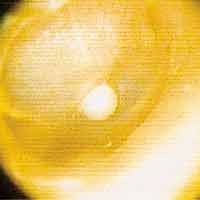 Congential tympanic membrane inclusion cyst | 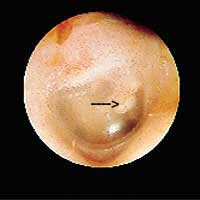 Congentital cholesteatoma (arrow) behind anterosuperior quandrant of intact tympanic membrane | ||
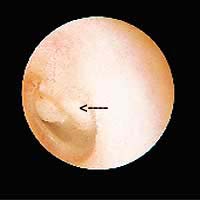 Congenital cholesteatoma (arrow) behind postsuperior quandrant of intact tympanic membrane | 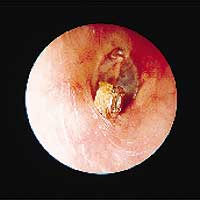 Tympanostomy tube extruded into external auditory canal | ||
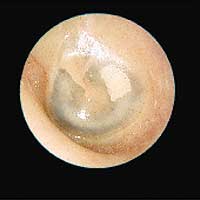 Tympanosclerosis, small plaque | 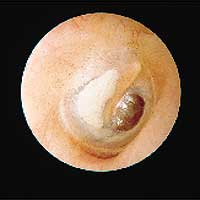 Tympanosclerosis, large plaque | ||
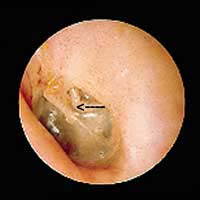 Posterosuperior retraction pocket with tympanic membrane draped over intact incudostapedial joint (arrow) |  Posterosuperior retraction pocket with erosion of the incudostapedial joint | ||
 Pars flaccids retraction pocket in an ear with serous otitis media | SOURCE: STEVEN HANDLER, MD | ||
Odd things in the eardrum
The first topic is tympanosclerosis. This is the most frequently encountered condition of this brief report. Oval or horseshoe-shaped chalky-white sclerotic plaques within the structure of the eardrum are caused by irritation from tympanostomy tubes or chronic inflammation due to chronic OME. In adults, but rarely in children, the process may also involve the middle ear structures and the mastoid cavity.
When limited to the TM, it may properly be called myringosclerosis. The lamina propria and the basement membrane of the chronically inflamed TM degenerates into a hyalinized scar with deposition of calcium salts into the scar. When secondary to tympanostomy tubes, the condition takes one year or more to occur. The sclerotic plaque is often horseshoe-shaped because of the clockwise migration of the TM epithelium and the tympanostomy tube from 2 o’clock to 9 o’clock. Unless the plaques occupy virtually the entire TM and the process involves the middle ear ossicles, there should be no significant hearing loss and no treatment is necessary. Healing of a tympanoplasty procedure is often impaired because of the impaired blood supply to the sclerotic plaques.
Next is implantation cholesteatoma. After extrusion of tympanostomy tubes, otolaryngologists recommend that periodic re-examination of the TM be scheduled at least every four months for several years. Rarely, on scheduled re-evaluation examinations, the site of implantation of the tympanostomy tube contains a golden colored cystic mass called an implantation cholesteatoma, a subtype of acquired cholesteatoma.
In theory, squamous debris accumulates and starts a growing cellular mass of keratinized material which undergoes necrosis and forms a growing cholesteatoma cyst. In time, the cyst will migrate medially into the middle ear cavity and continue to grow, causing damage to the malleus and incus bones and possibly perforation of the eardrum. Management includes either immediate referral to an ENT or a short period of watchful waiting not to exceed a few months, to be certain that the suspicious lesion is not a transient loculated collection of middle ear effusion. Further evaluation may include otomicroscopy, thin-section high resolution computed tomography (CT) scan and audiograms. Definitive treatment is complete excision of the cyst and tympanoplasty of the defect in the eardrum. Follow-up otomicroscopic examination for at least two years is recommended, and it may be valuable to consider exploratory tympanostomy under general anesthesia six months after excision of the cyst.
Odd things behind the eardrum
First on the list of odd things behind the eardrum is retraction pockets During almost three decades of general pediatric practice, I have diagnosed more than 50 retraction pockets during routine otoscopy, often during a well-child assessment.
Children who have chronic Eustachian tube dysfunction, often with a history of one or more sets of tympanostomy tubes for chronic middle ear effusion, are at greater risk for this condition. In the typical case, retraction pockets are located in the posterior-superior quadrant of the eardrum or the pars flaccida, but they may occur in any other quadrant, particularly at the site of an extruded tympanostomy tube.
When the TM loses its middle radial layer of fibers that give structural strength to the TM, a dimeric circle of atrophic TM is seen. These atrophic areas may be located any place in the pars tense part of the TM. When there is chronic Eustachian tube dysfunction and excessive negative middle ear pressure overtime, the dimeric TM is prone to form circumscribed pockets of invagination called retraction pockets. Loss of the structurally important radial fibers causes that small circle of dimeric TM to invaginate into the middle ear, somewhat similar to a finger thrust into a spherical balloon. The TM retraction pocket appears like a circular defect in the TM when visualized with a hand-held otoscope. If the retraction pocket extends deeply into the atelectatic (marked negative pressure with medial displacement of the eardrum) middle ear, it may not be possible to visualize the base of the pocket. It is important to find out if the apparent “hole in the eardrum” is indeed a TM perforation vs. a deep TM retraction pocket.
Retraction pocket
In-office diagnosis is facilitated if the pediatrician performs pneumatic otoscopy with moderate negative pressure applied by bulb or mouth. If the “hole” is a perforation of the TM, the TM will be immobile when moderate negative pressure is applied. If the “hole” is a deep retraction pocket, much of the TM will briskly move laterally toward the examiner. Once a true deep retraction pocket is diagnosed, the next important bit of information concerns whether the retraction pocket is pexed (fixed scar) on the mucosal lining of the promontory of the temporal bone. Application of a bolus of positive pressure via the Eustachian tube using Politzer technique can aid in the differential diagnosis of fixed retraction pocket vs. mobile retraction pocket.
When a 30 cc bolus of air under positive pressure is introduced into the middle ear, the eardrum will be distended. Should the retraction pocket be mobile (not fixed), the circumscribed area of the TM will balloon outward even more than the rest of the TM. Should the retraction pocket be fixed to the promontory, effective use of the Politzer technique will not be able to distend the pocket. Fixed retraction pockets should be referred to an ENT specialist without delay while mobile retraction pockets can be followed for a short time before referral. Medical management of mobile retraction pockets include daily application of Politzer’s technique of introducing positive pressure by means of a 1 oz Devilbis bulb syringe or by one of the commercially available devices such as Mathis middle ear insufflator.
The floor of the fixed retraction pocket may extend into the epitympanic recess and may be the nidus for an epitympanic cholesteatoma, which is impossible to visualize with the hand-held otoscope. Careful exploration of the depth of the retraction pocket under general anesthesia, along with an exploration of the middle ear space and epitympanic space, should ensure that no cholesteatoma is overlooked at the time of tympanostomy tube insertion for deep retraction pockets. Complications of chronic deep retraction pockets: In time, deep retraction pockets envelop the long arm of the incus bone or the inco-stapedial junction, causing ischemic necrosis, dissolution of the ossicular matrix and ossicular discontinuity with resultant permanent conductive hearing loss.
In addition, keratin material from the invaginated TM epithelium can flake off the surface of the eardrum and set the stage for a growing aural cholesteatoma. These may be hidden in the epitympanicrecess. Surgical correction of deep retraction pockets with adhesive OM (TM is scarred to the promontory) is often more complicated than simple myringoplasty and tympanostomy tube insertion.
Interposition grafts
It may be necessary to dissect the scarred area of the TM free of the attachment to the promontory. The atrophic part of the TM containing the retraction pocket is excised, leaving a circular defect in the TM. Interposition grafts of temporalis fascia, cartilage or artificial material may be inserted between the former retraction pocket and the promontory. The purpose of the interposition graft is to reduce the chance of reformation of retraction pocket when the tympanostomy tube becomes occluded or extruded. The defect in the TM is closed by tympanoplasty procedure. Continued middle ear ventilation is assured by insertion of a tympanostomy tube, usually in the anterior-superior quadrant of the TM. After the tympanostomy tube is extruded spontaneously, the tympanoplasty site is still prone to form another retraction pocket. As such periodic reexamination under the otomicroscope is advisable.
Characteristics of cholesteatomas
Mesotympanic cholesteatomas can also form behind the eardrum. An aural cholesteatoma is a benign, cyst-like tumor with a matrix of shed cells surrounded by layers of keratinized epithelium and usually enclosed by a pseudo capsule and located in the middle ear cleft and mastoid. Resembling a sebaceous cyst in form, it has been described as a misplaced “zit.” These cystic lesions are believed to arise from embryonic rests.
Cholesteatomas are not true neoplasms but share some properties with neoplasms, such as growth over time and local destruction. Pressure-induced local ischemic necrosis of middle ear and mastoid structures inevitably occurs when timely diagnosis and excision is not carried out.
Cholesteatomas are also locally destructive because they contain lytic enzymes which leak out of the cyst and sometimes destroy the three middle ear ossicles and cause perforation of the TM. Bacteria including Staphylococcus species, Pseudomonas species and respiratory anaerobes, thrive in the matrix of a cholesteatoma and can escape from the cystic prison and add to the destruction of the middle ear structures. Middle ear cholesteatomas have the biological propensity of invasion of continuous areas such as the epitympanic recess, bone, and brain.
Cholesteatomas may be congenital or acquired. Congenital cholesteatomas are believed to be less frequent. A congenital cholesteatoma must have an intact TM that has never been violated by perforation or blast injury. In addition, the child should have had few, if any, episodes of OM of any type. Acquired cholesteatomas arise from retraction pockets, the most common cause of acquired cholesteatoma, chronic OM and penetrating trauma to the TM. Intact cholesteatoma sacs are usually asymptomatic for many months or even years. When the integrity of the TM is breached because of the local destructive effects of a cholesteatoma, there may be intermittent or chronic foul-smelling cheesy otorrhea from that ear canal. The lesion may also grow laterally and destroy the scutum of the superior part of the distal ear canal.
Granulation tissue can also be seen because of the products of inflammation, infection and angiogenesis. Every year I diagnose one or two cholesteatomas that usually appear like an off-white or golden colored spherical structure in the posterior-superior quadrant of the middle ear with an intact TM. However, I have found them in the other three quadrants also. Typically, the cholesteatoma is adherent to the TM and will not separate from the TM when positive pressure is introduced into the middle ear by Politzer’s technique. Recognition of a cholesteatoma requires diligent otoscopy with every child, paying particular attention to the area of the pars flaccida and the posterior superior aspect of the pars tensa. Several middle ear structures can resemble a cholesteatoma, and I have been fooled on several occasions.
Methods of treatment
Examples of cholesteatoma look-alikes include loculated, golden-colored spherical collections of middle ear effusion, the overhang of an epitympanic shelf, a tympanosclerotic plaque, retraction of the TM over the inco-stapedial joint and true tumors of the middle ear space. If I suspect that the structure may be a cholesteatoma, I schedule one or two follow-up re-evaluation visits over the next 30 days. If the structure persists, I immediately refer to a pediatric otolaryngologist after a telephone call to ensure an early appointment. I draw a simple diagram of the suspected lesion and photocopy my office notes and give those to the child’s mother and instruct her to present the notes to the otolaryngologist.
Cholesteatomas are treated by complete excision of an intact cyst and by careful debridement of escaped squamous debris. Contrast enhanced thin-section CT scan of the middle ear and meticulous exploratory tympanostomy with exploration of the attic, if warranted, can help to ensure gross total eradication of the lesion. However, the probability of recurrence of cholesteatoma is estimated to be about 50%. Therefore, scheduled tympanostomy and a “second-look” are mandatory six to eight months after the initial surgical procedure and otomicroscopy or thin section high resolution CT scan should be performed periodically for several years thereafter.
Cholesterol granuloma
Finally, cholesterol granuloma (idiopathic hemotympanum) can also be found behind the eardrum. During the past 29 years of pediatric practice, I have encountered at least six children with a gun-metal blue colored middle ear effusion similar to trauma tichemotympanum but without any history of head or ear trauma. There is scarcely any information in the pediatric literature and only a few articles in the English language otolaryngology literature. The condition causes fullness of the ear and mild or moderate conductive hearing loss, without significant pain.
Pathogenesis of this condition is the presence of granulation tissue in the middle ear cleft with inflammation and a chocolate-brown, sterile middle ear effusion. The red blood cells had broken down and left products of their disintegration, including cholesterol, in a granulomatous matrix. These crystals refract and reflect light from the otoscope, producing the unusual blue color. In the otolaryngology literature, management of idiopathic hemotympanum ranges from watchful waiting in “early cases” to tympanocentesis and insertion of tympanostomy tubes and, in refractory cases, mastoidectomy to remove cholesterol granuloma in the mastoid antrum. Although conventional wisdom dictates that children with this condition must be referred to an ENT specialist as soon as possible, I have followed several of these children for up to three months without expensive invasive procedures. One child had spontaneous resolution without any medical, physical or surgical intervention. Another child unexpectedly responded to insufflation of the middle ear with Politzer’s technique, done daily at home using a 1-oz plastic-tipped nasal aspirator.
Another child underwent simple tympanocentesis of the middle ear with slow resolution. Three children were referred to an ENT for aspiration and tympanostomy tubes; none of them underwent mastoidectomy. The differential diagnosis of a “blue” color behind the eardrum includes traumatic hemotympanum, especially with a basilar skull fracture or blast trauma to the TM and a dehiscent or high-riding jugular bulb.
For more information:
- Sobol SM, Reichert TJ, Jaw KD, et al. Intramembranous and mesotympanic cholesteatomas associated with intact tympanic membranes in children. Ann Otol Rhinol Laryngol. 1980;89:312-17.
- Alzamil KS, Linthicum FH Jr. Tympanosclerosis. Am J Otol 1999:20:686-7.
- Schiff M, Cantanzaro A, Poliquin JF, et al.Tympanosclerosis — A theory of pathogenesis. Ann Otol Rhinol Laryngol. 1980;89:1.
- Schwartz RH. Iatrogenic implantation cholesteatoma: An unusual complication of tympanostomy tubes. J Pediatr. 1979;94:432-433.
- Yoon TH, Schachen PA, Paparella MM. Pathology and pathogenesis of tympanic membrane retraction. Am J Otolaryngol. 1990;11:10-17.
- Tay HL, Mills RP. Tympanic membrane atelectasis in childhood otitis media with effusion. J Laryngol Otol. 1995;109:495-498.
- Ars BM. Tympanic membrane retraction pockets. Etiology, pathogeny, treatment. Acta Otorhinolaryngol Belg. 1991;45:265-267.
- Sade J, Avraham S, Brown M. Atelectasis, retraction pockets and cholesteatoma. Acta Otolaryngologica. 1981;92:501-512.
- Schwartz DM, Schwartz RH, Radfield NP. Treatment of negative middle ear pressure and serous otitis media with Politzer’s technique: An old procedure revisited. Arch Otolaryngol. 1978:104:487-490.
- Schwartz RH, Grundfast KM, Feldman BA, et al. Cholesteatoma medial to an intact tympanic membrane in 34 young children. Pediatrics. 1984;74:236-240.
- Sheely JL. Cholesteatoma surgery in children. Am J Otol. 1985;6:170-172.
- McGill TJ, Merchant S, Healy GB, et al. Congenital cholesteatoma of the middle ear in children: A clinical and histopathological report. Laryngoscope. 1991:101:606-613.
- Schwartz RH, Grundfast KM, McAveney WJ, et al. Congenital middle ear cholesteatoma. Am J Dis Child. 1983; 137:501-502.
- Rosenfeld RM, Moura RL, Bluestone CD. Predictors of residual recurrent cholesteatoma in children. Arch Otolaryngol Head Neck Surg. 1992;118:384-391.
- Sade J, Halevy A, Klajman A, et al. Cholesterol granuloma. Laryngoscope. 1983; 93:981-988.
- Gschwendtner JF, Geurkink NA. The blue eardrum — idiopatic hemotympanum. Cleve Clin Q. 1971;38:39-42.
